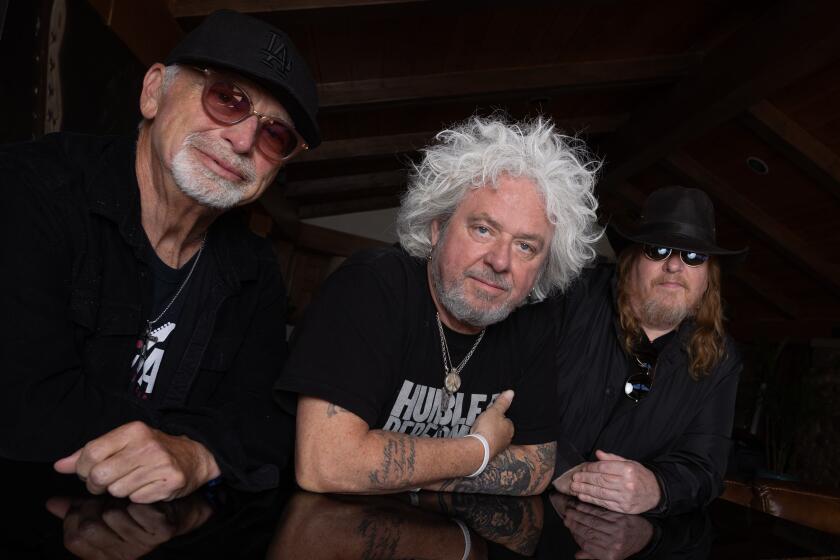Arranger for Tommy Dorsey, Glenn Miller
Bill Finegan, an architect of the big band sounds of Tommy Dorsey and Glenn Miller who later traded in commercial success to co-create the Sauter-Finegan Orchestra, which produced music that still stands as some of the most experimental of the swing era, has died. He was 91.
Finegan died Wednesday at a Hospital in Bridgeport, Conn., from complications of pneumonia.
In 1938, Dorsey bought Finegan’s score for “Lonesome Road” and played it for Miller, who offered the young arranger a job. Between 1938 and 1942 Finegan wrote more than 300 arrangements for Miller, including some of the band’s biggest hits: the classic “Little Brown Jug,” “Sunrise Serenade” and “Song of the Volga.” Finegan also wrote arrangements for the films “Sun Valley Serenade” in 1941 and “Orchestra Wives” in 1942, and had begun a lifelong profession as a teacher.
One of his students was Nelson Riddle, celebrated arranger for Frank Sinatra.
“Bill’s arrangements for Glenn [Miller] demonstrated that great originality and inventiveness are possible even within the restrictive confines of a highly stylized band, which the Miller Orchestra was,” Riddle said in the book “September in the Rain: The Life of Nelson Riddle.”
When they met, Riddle was a young trombone player, intent on becoming a professional musician. Finegan encouraged him to leave the trombone behind and focus on writing.
“I cared a lot about what I did, and I think I transferred that to Nelson,” Finegan said in “September in the Rain.” “I once saw a documentary on the artist Chagall. In it, Chagall said, ‘Never say “That’s good enough.” ’ That’s what I think I taught him.”
Finegan worked intermittently for Dorsey and wrote arrangements for the film “Fabulous Dorseys” in 1947. He also wrote for bandleaders Horace Heidt and Les Elgart.
But Finegan bristled at the restrictions placed on the writing by the industry and bandleaders. In 1952 he teamed with another leading arranger, Eddie Sauter, to create a band that would explore and expand the concept of the jazz orchestra.
Time magazine called the group “the most original band heard in the United States in years.” Their albums include “New Directions in Music,” recorded in 1953, “The Sons of Sauter-Finegan” (1955) and “Adventure in Time” (1956).
The band lasted about five years and became known for its rich harmonics, extraordinary voicing and varied instrumentation. In addition to the standard instruments, the orchestra included kazoos, toy xylophones and recorders.
“They came up with this idea to supplement the big band with all this extra orchestral instrumentation that would allow them to expand their writing and give them more color to work with,” Finegan’s son, James Finegan, who is also a musician, told The Times. “They had very specialized musicians, very high level musicians.”
Humor, fun and adventure came with the music. When the orchestra’s record label required them to play show tunes, the group responded by playing them on kazoos.
Born April 3, 1917, in Newark, N.J., Finegan grew up in a family of musicians. Like his parents and siblings, he played piano. While still in high school in Rumson, N.J., Finegan formed a band and began writing for it.
In the early 1930s the band played on Major Bowes’ Original Amateur Hour, a popular radio program that featured a talent competition.
Finegan’s band won and was hired to tour the U.S. and Canada, performing in Bowes’ vaudeville-style shows on a bill that might include a dog act, an opera singer and somebody playing a classical piece on the piano while wearing mittens.
“The humor of it all never escaped him,” James Finegan said.
During World War II Finegan served in the Army, and after his discharge he spent time in Europe and studied at the Paris Conservatory; he also studied with composer Stan Wolpe.
In the years after the breakup of the Sauter-Finegan Orchestra, Finegan wrote music for commercials and taught at the University of Bridgeport and elsewhere.
He also wrote and arranged, notably with vocalist Carol Sloane, saxophonist Sonny Stitt and the Mel Lewis Ensemble in the ‘80s. His most recent work includes arrangements for Warren Vache’s “Don’t Look Back” and for the Gotham Wind Symphony in 2007.
“My father is obscure because he never was interested in the limelight,” James Finegan said. “He was a behind-the-scene guy until the end. He just cared about his work.”
Finegan, who was a widower, is also survived by a daughter, Helen Dzujna, of Shelton, Conn., and three grandchildren.
--
More to Read
The biggest entertainment stories
Get our big stories about Hollywood, film, television, music, arts, culture and more right in your inbox as soon as they publish.
You may occasionally receive promotional content from the Los Angeles Times.










